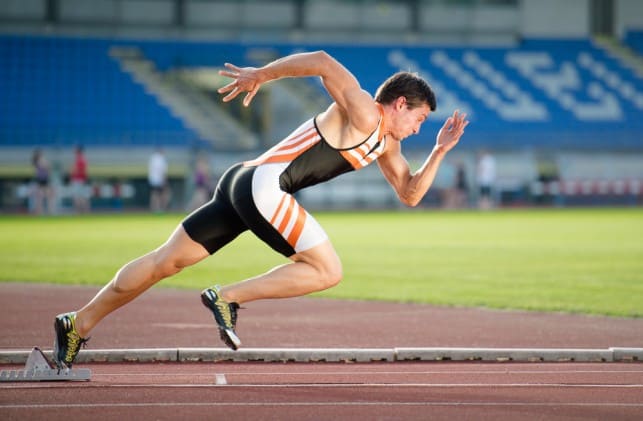How to Sprint Faster
Sprinting is the foundation of High-Intensity Interval Training (HIIT), and will make your legs big, strong, fast, and powerful. Sprints are great for developing endurance, but also for developing lean muscle mass and speed strength. If you want to develop your writing skills you can visit services like thesishelpers.com, but for sprinting these tips will teach you how to sprint faster.

Ever seen a skinny sprinter? I didn’t think so.
Sure, squats are the almighty kings of the Gym Exercise Kingdom; but sprints are like the kings of the Functional Exercise Kingdom whose jacked-up, super-lean army of massive wheels is constantly trying to overthrow the squat as the #1 top leg exercise.
You think you know how to sprint right, but do you?
Here Are 21 Tips You Can Follow to Improve Your Sprinting

- Start on the correct foot. When standing, have someone push you lightly from the back. The foot that moves first should be your front foot in the starting blocks. It will move first and fastest (push off with your front foot).
- Explode out of the starting blocks. Getting a jump on the competition out of the blocks is vital to sprinting faster. Starting strength and starting speed are always important aspects of maximal effort exercise. To get that quick jump, your leg angle should be about 45 degrees, your stride should be short, and your arms should help you gain that initial momentum.
- Touch the ground only with your toes. Aside from pushing off with your toes, your toes should really be the only part of the foot to come in contact with the ground. Anything else will just slow you down.
- Push off with your toes. You should be pushing off with the toes of your rear leg to maximize propulsion.
- Kick your own butt. Once your toes push off at the end of your stride, your legs should follow through by essentially kicking your butt with your heel. Practice butt-kicks while warming up before a sprint. Update: a reader says, “you shouldn’t be kicking your butt with your heel. It should pass through beside your knee”.
- Run with a circle (not IN a circle, WITH a circle). Your foot movement should be circular, not elliptical. Videotape yourself from the side while sprinting to check this. Your toes should touch down only in the bottom quadrant of the circle in the direction you are running.
- Use dorsiflexion to increase propulsion. As soon as your toes push off, you should pull your toes and feet up towards your shin. This helps you to sprint faster by causing the calf muscle to contract and propel the body forward.
- Don’t break your stride. When your toes touch down they should already by moving backward, thanks in part to a circular foot motion and the dorsiflexion mentioned previously. Stepping straight down breaks your stride.
- Kick your knees up. At the top of your stride, your thigh should approach a parallel angle to your running surface. Practice high knee kicks while warming up before a sprint. Always be prepared to protect your knees as necessary, as knees are a sprinter’s best friend. When you’re feeling sore or tight but you still have to train, using knee wraps can help protect your knees by adding compression and stability.
- Shorten your stride. Your foot should not land out in front of your body, rather it should land directly under your center of gravity. This is a common misconception when sprinting. By touching your foot down in front of your hips, your foot will actually act more like a break than an accelerant.
- Increase the speed of your stride. In keeping your strides shorter, you should also be able to quicken them. The more times your toes push off behind you, the faster you will run.
- Swing those arms. Make an L shape with your arms. Pump your fist as high as your chin and pump your elbow back as far as possible for momentum.
- Conserve energy. You’ve got your stride and your arm swing. Any other motion just wastes precious energy. That includes unnecessary tension in any other muscle groups. Stretch and shake the tension out of your body before a sprint.
- Sprint short distances. To maximize speed you want to train only when you are the fastest. That means you should not sprint for longer than 20-30 seconds in one burst. After 30 seconds your effort will naturally decrease to submaximal, and you don’t want this.
- Eat carbs. You should consume some complex carbs before your sprint session. Consider eating some fruit an hour before training.
- Update: You should be looking down in the drive phase of the race but slowly start to look forward after about 30m. Looking anywhere else will make your body want to run in that direction, which is wasted energy. That includes looking down after the 30m mark. Do you want to run down into the ground or in a straight line, straight ahead? Right. So don’t look down. Looking down also impairs your breathing.
- Harmonize your breathing. Rather than breathing randomly, you should breathe in with your nose and out with your mouth in a steady rhythm with your strides. Find a rhythm that works best for you and stick with it long enough to make it natural.
- Accelerate at all times. Ideally, you should be moving faster at the finish line than at any other time during the sprint. You never want to decelerate during the sprint, as it trains your body to be slower. If necessary during a long sprint, you should pace yourself by sprinting with a moderate speed at first and increasing acceleration through the finish line.
- Lift weights. You might be surprised to know that all of the muscles in your body are required for sprinting, with the possible exception of the biceps which really aren’t good for much except chin-ups and curls.
- Hamstrings are the most important muscle for a fast sprint.
- The quadriceps are the second most important muscle for a fast sprint.
- You are going to need strong calves for pushing off with your toes.
- Your shoulders, chest, and back need to be strong for pumping your arms.
- The core needs to be strong to keep your body straight and aligned properly.
- A strong neck will help keep your head from bouncing to and fro while sprinting.
- Get a little help from your friends. Train with people who are faster than you. Constantly striving to catch someone, will provide the motivation you need to get faster. Training with someone slower than you will not be as challenging.
- And finally: practice. If you want to be a good sprinter, get out and practice. Run a wide variety of sprint lengths including 20, 40, 60, 80, 100, and 200 meters. You might tend to slow down towards the end of a 200-meter sprint but always strive for positive acceleration.
Even if you can’t get out to practice due to the weather, there are still training options available. By using an indoor treadmill, a rowing machine, a Stairmaster, or an elliptical machine, you can still set the program to HIIT or sprint in order to train the fast-twitch fibers needed to sprint faster
Tags: Conditioning, hiit, run, running, Sports, sprint, sprinting











Absolutely! Once you’re comfortable getting into this position, add more steps to the drill. Mimic this movement when running sprints to ensure a powerful start.
If you are serious about getting faster please visit simplyspeeed.com ! GOD bless in Jesus Name
nice techniq 4 good sprint runner.
nice tips to be a good sprint runner.
Slick post excellent tips, sprinting is so underrated and underused but is just as effective as any exercise you can do.
I never did sprints until I got put in the 200m and these tips really helped.
another tip is not to tense your wrists because it uses more energy. just leave them out and straight.
When you come out of the blocks, you should push off BOTH feet and it should feel like you’re jumping out of the blocks. The foot that you take your first step with is your back foot, which is the power foot.
You should be pushing of with both feet, but it should be 80% with your front foot and 20% with your back foot. If you were to jump out of your blocks you would be very off balance. You definitely want your drive foot, which would be your back foot, to touch the ground first before your power foot, which is actually your front foot, to touch shortly after
Point 4? You should be pushing off your front foot not back foot! Just ask Linford Christie!!
#20 is a huge one for me. Having someone to chase always helps me push myself. Thanks for this article, lots of useful info!